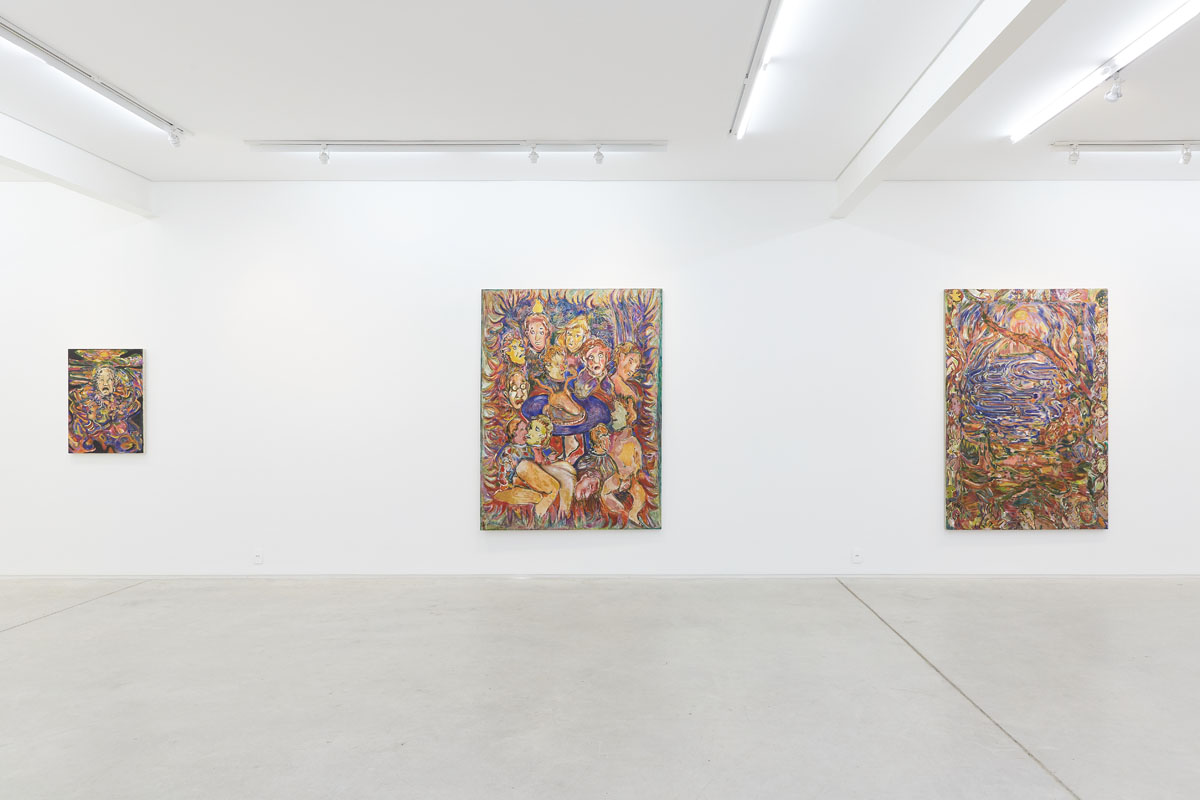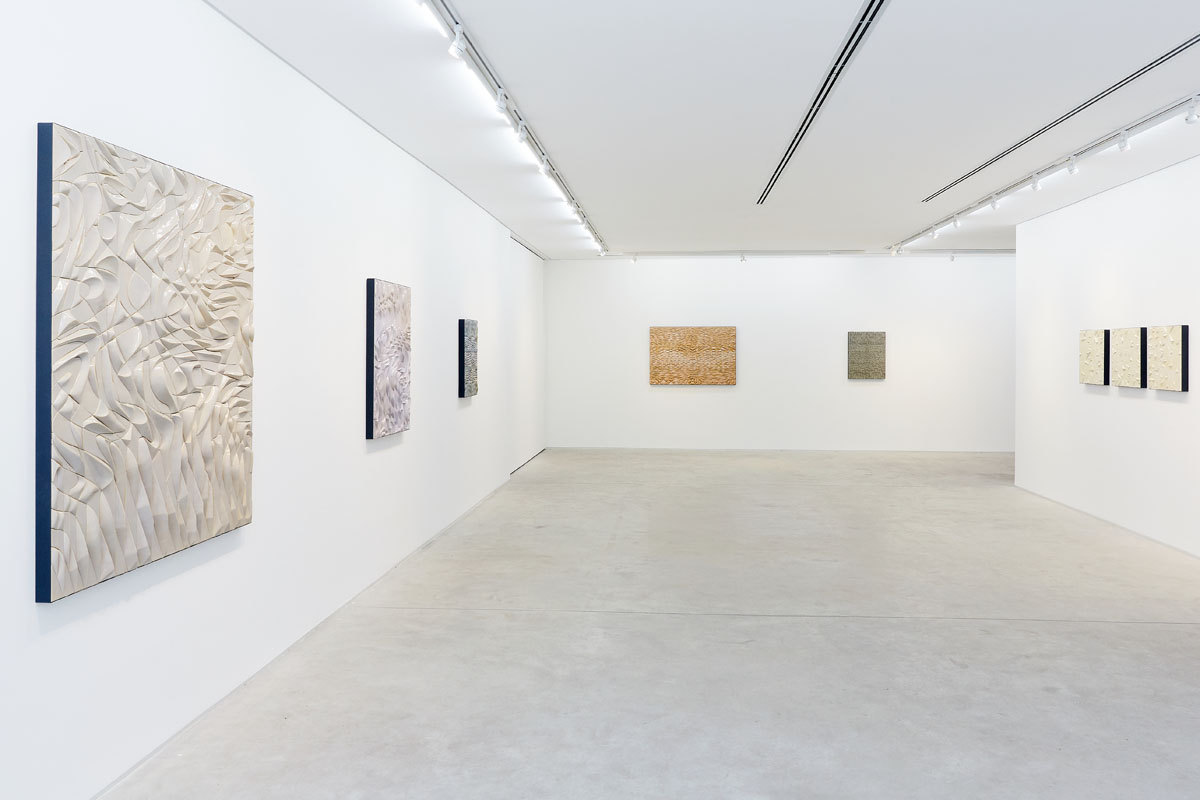30.09.2020
Simões de Assis Gallery, São Paulo, Brasil
19 de septiembre de 2020 – 31 de octubre de 2020



Mirroring Astonishing by Maya Weishof
In my first visits to Maya Weishof’s studio at the Pivô Residence [1] in early 2019 her obstinate handling of a large scissors, different color pencils and some brushes called my attention. It looked like some non-choreographed dance, of little understanding to passers-by in the halls, but not to the drawings scattered along the walls of the cubicle studio, since they always know what that is all about.
To Maya, some drawings are premises to paintings; others, are abandoned promises. The fast traces on notebook pages coexist with ongoing paintings and others drying among patches stomped on and books with stains.
How does all this connect? The sellotape soon loses its glue in the dust in downtown São Paulo City Capital, muddling fragments of bodies, little monsters that are half people half plants, talking heads, and all sorts of non-identified anthropomorphic shapes. Nothing is glued on in Maya Weishof’s work, but everything is interconnected, following free, frenzied rhythm. From James Ensor to Peter Doig, from the Ugly Duckling to Jewish traditions, Maya’s lysergic (but not psychedelic) compositions follow a peculiar palette, a sort of subtropical Sonia Delaunay which moves—elegantly and irreverently—between scatology and eroticism, haute couture and the underground.
Another Curitiba-born, Paulo Leminski, wrote:
What is the use of painting
if not to convey
precisely the searching
of what it can best portray
while handling forty
enigmas times seventy? [2]
I always prefer enigma to undeniable evidence. And in order to talk about Maya Weishof’s curling practice we chose some shared exercise, some sort of free association game where drawing and writing get together at a place that stops before argument and objective description. “There was never such a thing, a blank page. Ultimately, they all cry out, so loud as to be pale” [3], says Leminski in another poem. And the starting point was exactly that: to overlap repertoires, affections, previous conversations and new digital sharing that took place from the impossibility to visit the artist and see the paintings due to Covid-19 pandemic.
Maya sent me a number of works that are part of the Espelho Espanto (Mirroring Astonishing) exhibition at Simões de Assis Gallery. We chose to talk about ten drawings, considering them as possible starting points to her unique universe, the so-called testimony-drawings that hold perforated themes and are constantly reconfigured.
A few days before the montage of the exhibition I finally saw the pieces in person. It was the first time I was facing recently finished paintings in so many months. I could finally talk to the artist without any electronic mediation, and see the drawings I had been writing about. I walked back home with my eyes overwhelmed by Maya’s colors, and left there some words I had been carrying in my pockets: we went on dwelling thresholds and talking about painting.
—Text by Fernanda Brenner
—
Ceramic Turbulence by Juan Parada
In the current times of 3D printers that slowly expel a thread of melted plastic to materialize a sequence of abscissas and ordinates, Juan Parada (born in 1979 in Curitiba, Paraná State, Brazil, currently living and working in São Paulo City Capital) explores an entirely different sculptural method. His reliefs, to be addressed here, are created from the alchemy of ceramic and its slow process—orchestrated by the hand and by the heat of fire—from the “humus” of the earth to the “lapis lazuli” of the stone. Differently from the millenary ceramic, however, such transmutation does not end in the firing process, but is extended to the versatile characteristic of the works and along its high resonance with life.
The process to create relief painting is actually free from the nostalgia of handicraft, when resorting to ceramic would stand as a reaction to modernity. Therefore, its first disegno is created through the use of a computer software. At times, it reproduces the propagation of sound waves (Sound Topography, 2017) or magnetic waves, and frequently takes up a square shape of vibrant colors defined by the intersection of multiple, undulating lines in different layers. The following stages are manual, except the firing process, of course. In Tethys Sunset (2020), for instance, the drawing is transferred to a clay board where it is engraved. Each element is then cut and given material prominence to create the relief. Those elements make up a volume that is a few centimeters high and are assembled on the plane surface as a puzzle. Then, through the use of a brush or spray, they are covered with a thin layer of paint or metallic powder. The firing and glazing process produce thin fissures, light dégradés, star shapes, subtle iridescences or even some delicate glitter.
The different micro patterns and luminous modulations are revealed to attentive viewers only, as in Geometric Stratification (Estratificação Geométrica – 2019), where the faceted shape of each module creates a combination of light and shadow, conveying unstable colors and shades. Parada considers ceramic an “elastic means”, of “subversive nature”, in opposition to the limitations imposed by its traditional use. Thus, shaped and harmonized in its composition, each work emerges as a labyrinth of one thousand entrances and exits through which the eye—channeled, since it is subject to this hypnotic guidance—constantly returns in its trajectory. As if interrupted in their movement, the petrified flows and waves—as frozen fragments of a continuum, capture the eye—here, a reminder of The Great Wave off the Coast of Kanagawa, the famous print by Hokusai (1830).
The complex undulatory geometry that guides the optical patterns of Strange Attractors I and II (Estranhos Atratores I e II) is a legacy from neoconcrete artists. Such as Lygia Clark, for instance. In 1960, her first Animal (Bicho) already associated geometric rigor to the variability of living beings, and was given to Sérgio Camargo, whose monochromatic reliefs, filled with small, cut-out cylinders were equally ambiguous. In addition to this obvious reference, Parada also gets inspiration for the characteristic movement of his patterns in the kinetic art of the 1960’s and 1970’s, such as Bridget Riley’s, Enrico Castellani’s, and Abraham Palatnik’s. His reliefs, however, as in Lines of Power (Linhas de Força – 2016), refer to biological elements—such as spider webs and the carapace or skin of certain reptiles—since above all, Juan Parada presents naturalistic, organic (even if visceral) aesthetics. Small sand waves created by ocean currents will serve, for instance, as the starting point for the reliefs in the series Compliment to the Water (Elogio à Água – 2018), whose moulds were created directly on Superagui beaches (especially preserved from human presence).
A naturalistic story, even ecological, can also be seen in the first transparent glass sculptures in the shape of a beehive that holds different vegetal contents (Series Encasing [Invólucros, 2013-15]), and is meant to be inserted in architectural reliefs. The Symbiotic Volumes (Volumes Simbióticos – 2011-12), however, evoke the basic forms of Minimal Art—as the L-Beams (1965) by Robert Morris—although one of the surfaces—either external or internal, holds abundant vegetation. Those shapes do involve viewers at times—in Anish Kapoor fashion—but on a very dense mould, made up of plants and flowers (Memory of Matter – Memória da Matéria, Museu da Gravura, Curitiba, 2012). By the way, this sort of environment was mineralized as late as 2018, in the work Glaciers (Glaciares), which incorporates a monochromatic ceramic all-over surface. It is a panoramic, immersion creation, evoking the panoramic curve of the Nymphéas, by Claude Monet, at the Orangerie Museum in Paris (1915-26).
Even if the tondo (circular) shape of certain reliefs echoes the history of shaped canvas, Parada leads viewers to the inner visual pattern, rather than offer them an object of study to be observed coldly from a distance (we have in mind Mark Rothko or Barnett Newman, who advocated a reduced distance between their work and spectators with the purpose of enhancing the feeling of immersion). That absorption tropism—both of the eye and of the body—is crucial in relief painting. Such practice is actually paradoxical in Parada: it leads to the coexistence, which is not simple, of the undulatory and phenomenal nature of life and the invariable hardness of the “lapis lazuli”, the geometric rigor of the pattern and the curved materiality of the relief, whose prominences and recesses evoke those shapes in the human body. A recent relief, Inverted Cascade (Cascata Invertida – 2020), displays a clear wave motif, that is true, but turned upwards, inverting the sense of gravity. Various excrescences, at times organic, recurrent to viscera, at times geologic, recurrent to rocks, emerge from those vertical waves. Their strangeness, which may raise certain aversion, refutes the ornamental label to which the artist could be wrongly associated. Having been developed for about ten years, as unique and promising as such practice may be, it is part of a wider historic perspective.
Parada’s artistic creation is rooted in the post-war years in the mingling of abstract art and perception psychology, optical rule and manual trace, kinetics and neo-concretism, geometry and psychedelia. Among the avant-garde actors, German Heinz Mack—founder of ZERO Group in 1957 with the works Metallreliefs or Lichtreliefs—starts a constant dialogue between order and chaos, matter and light that was important for Juan Parada. Although abstract, his two works evoke the action of natural elements—sunlight, wind, and rain in aquatic or desertic surfaces—whose appearance owes nothing to chance but rather comes from the action of fluid forces over malleable material, without at the same time disregarding the rigorous economy of Lee Ufan’s visual means (with simple touches of paint on relief on immaculate canvases). The general result of this process naturally evokes Piero Manzoni’s pleated fabric covered with white kaolin in his series of “Achromes”. However, while the work of the Italian artist reminds us of the folds in the sculptures of Ancient times, that of Mack’s and Parada’s stand out from their natural echo and their perceptive dynamics.
Heinz Mack gave his view about the desire to separate the phenomenic and perceptive aspects of the work from its strictly material support: “I could no longer see a metal relief, but a vibrating, pulsating structure made of light. My feeling was that the structure hovered over a metal relief, getting detached from it, as the reflection of light on the ocean that starts vibrating under intense sun and taking up the appearance of a rug of light made of dancing light” [4]. Resorting to different aesthetic and material terms, through a material, tangible mould, Juan Parada’s aim is to make us aware of the undulatory, rhythmic, corporified nature of life, as the last resistance to the transformations in the digital world.
—
In 2019, Maya Weishof attended the residence of Pivô Arte e Pesquisa in São Paulo.
Leminski, Paulo. Sete Assuntos por Segundo in Toda Poesia. Companhia das Letras, 2013, p. 254.
Leminski, Paulo. Plena Pausa in Distraídos Venceremos. Companhia das Letras, 1987.
Heinz Mack, cited by Yvonne Schwarzer, Das Paradies auf Erden schon zu Lebzeiten betreten. Ein Gespräch mit dem Maler und Bildhauer Heinz Mack, Witten, ars momentum Kunstverlag GmbH, 2005, p. 15.
Comentarios
No hay comentarios disponibles.